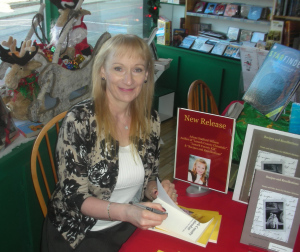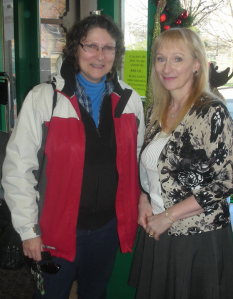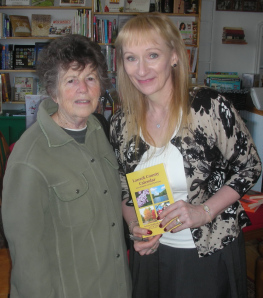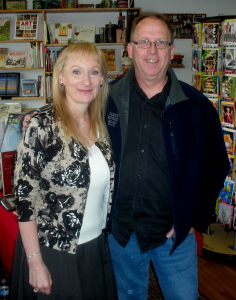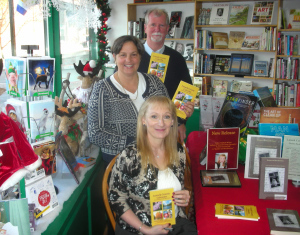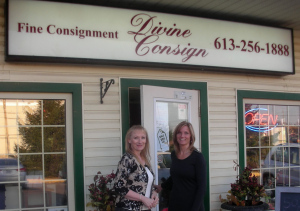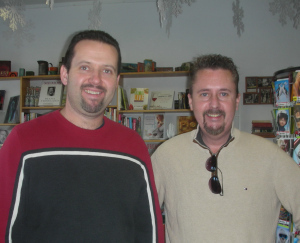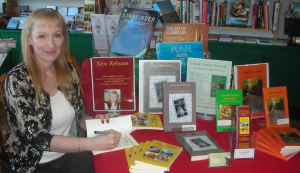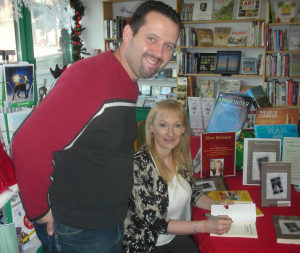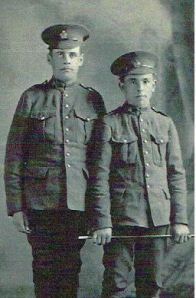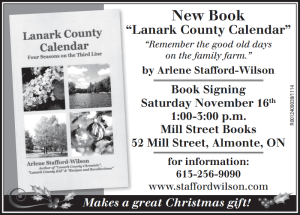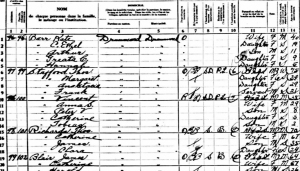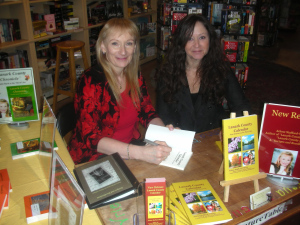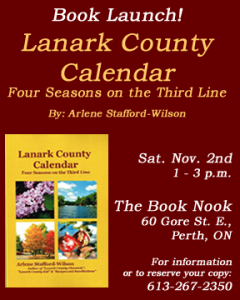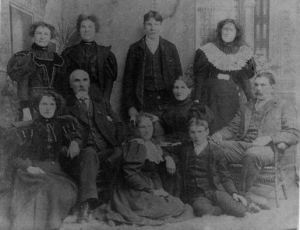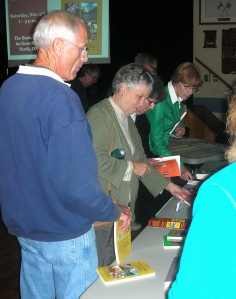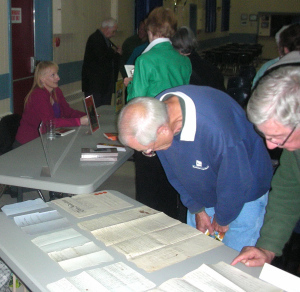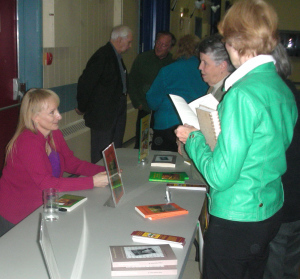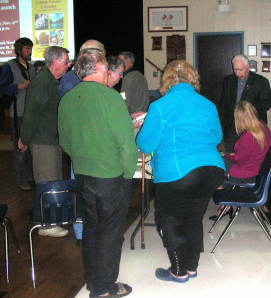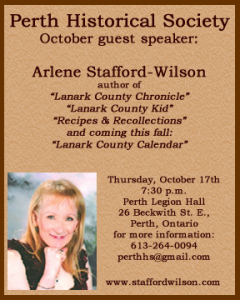Arlene Stafford-Wilson's Blog, page 57
November 17, 2013
Book Signing at Mill Street Books, Almonte Nov 16 2013
What a beautiful, sunny day in Almonte! The unseasonably warm weather and bright sunshine caused the streets of Almonte to be busy with residents and visitors, spending the day exploring the picturesque town. Mary and Terry Lumsden’s cheerful store Mill Street Books enjoyed steady traffic throughout a busy day. Centrally situated, at 52 Mill Street, the store’s ideal location, along with the mild temperatures meant that there was never a lull in business and kept the owners occupied serving a steady stream of customers. It was an ideal day for a book signing and many friends old and new stopped by for a chat and to have their copy of ‘Lanark County Calendar’ signed – some to keep for themselves and some to place under the Christmas tree.
It’s always a pleasure to see Janet Dowdall, President of the Lanark County Genealogical Society. Janet took time out of her always hectic schedule to drop by and say hello and wish us well with the new book. As always Janet and I chatted about our latest genealogical trials and triumphs and caught up on some of each other’s recent research.
Another long-time Lanark County Genealogical Society member Helen Gillan stopped by. Helen has been a volunteer with the Genealogical Society for many decades now and has a wealth of information on local history and families. We had a great chat and discussed some of the Ferguson Falls area genealogy we’ve each been pursuing. It was great to see Helen again!
It was so nice to see former classmate and neighbour from the Third Line – David Somerville and his lovely wife Joan. David and I chatted about his novel and mused that this time next year he may be signing his book for me. We shared many laughs and agreed to get together for dinner soon where we’d have more time to catch up.
We met a lovely couple – Alan and Peggy Mackey, parents of friend Peter Mackey and had a great chat with them. Peter has been a driving force in the Executive at Unifor Local 6004 for many years and has come to the assistance of countless members throughout his career. It was a real pleasure meeting your folks Peter!
What a nice surprise to see Blair Boisvenue, busy hockey-Dad, who took the time to stop by and have a book signed for a family Christmas gift. It’s always nice to see Blair, and he and Kevin had a nice chat and agreed to meet for lunch soon and bring each other up to speed on what they’ve been up to.
Once again, many thanks to Mary and Terry Lumsden for hosting the book signing. Their store is beautifully decorated; all ready for the Christmas season. If you’re in the Almonte area, be sure and stop by and see their great selection of books for all ages and interests. http://www.millstreetbooks.com/Mill_Street_Books/Home.html
Finally, a trip to Almonte would not be complete without a visit to our friend Wendy Gervais’ delightful store Divine Consign. Despite the fact that Wendy’s store was quite busy, we had a chance to talk and catch up on some of the news since we last spoke. Wendy’s got a lovely selection of designer clothing and handbags – something to suit everyone. http://www.divineconsign.ca/
All in all, it was a busy day in Almonte, and so nice to see lots of familiar faces and to meet some new folks as well. The book signing was a great success, and we look forward to our next visit to Mill Street Books!


November 10, 2013
Family History Tip: Researching and Remembering Our Veterans
“We are the Dead.
Short days ago we lived,
felt dawn, saw sunset glow,
loved and were loved,
and now we lie in Flanders Fields.”
— John McCrae
Over 600,000 men and women enlisted in the Canadian Expeditionary Force (CEF) during the First World War (1914-1918) as soldiers, nurses and chaplains. The CEF database is an index to those service files, which are held by Library and Archives Canada.
This free online searchable database includes over 600,000 men and women who participated in WWI (1914-1918) including soldiers as well as nurses and clergy:
http://www.collectionscanada.gc.ca/databases/cef/index-e.html
These service files contain the name, address, service number, name of the next of kin, their physical description , skin colour, eye colour and scars or identifiable markings, and the unit number and location where they signed up for service.
On this site you can find links to the soldier’s file which contain medical and pay records and encompass a more detailed personal history of the soldier and includes the specific units where they served after going overseas. The soldier’s full service records are not available online, however, they may be ordered for a fee from Library and Archives Canada.
Also available are links to the Canadian Virtual War Memorial if the soldier died while in service.
http://www.veterans.gc.ca/eng/collections/virtualmem
War Diaries – This is a link to the diaries of the unit, not to personal diaries, but of the records of day to day life in a particular unit. This will give you great insight to how your ancestor lived in times of war in their group as they trekked across Europe and participated in various battles – some successful and some not.
http://www.collectionscanada.gc.ca/archivianet/020152_e.html
Using the resources and links mentioned in this article I was able to search and locate Harry Stafford’s enlistment papers, his detailed medical files including x-ray images and comments from attending physicians, his pay statements, physical description, and name and address of his next of kin.
I was also able to find out about the specific battle where he was wounded and subsequent hospitals in Europe where he received treatment. The records also state his date and condition at discharge and pay records of any amount owing.
Harry’s story begins with the 130th Battalion, Lanark and Renfrew Scottish Regiment which was the ’130th also known as the ‘overseas’ Battalion, based in Perth, Ontario. They began recruiting in the fall of 1915 in Lanark and Renfrew Counties.
This is Harry’s story:
Nine-year old Harry stood by the shore and watched in horror as his eldest brother Wilfred struggled to the surface again and again, until he finally slipped out of sight into the deep blue waters of the Mississippi River near Lanark.
Harry and his brothers often played near the water, although none of them could swim. The four brothers stood on the shore that fateful day in July and skipped stones on the surface of the water just as they had so many times before.
Wilfred, two days shy of his thirteenth birthday was the oldest of the four. He took great pride in showing his younger brothers how to pick the longest flattest stones. He coached them on how to hold the stones on their flat side and throw them parallel to the water so they would skip farther along the waves. Dick, at age ten, was beginning to get the hang of it. Harry and his twin brother Frank had turned nine two months before and were doing their best to keep up with the older boys.
Harry, the stronger and more athletic of the twins was trying to help his brother Frank as he struggled with the task. Frank had kyphosis which meant that he had a severe curvature of the spine. People in those days referred to Frank as a ‘hunchback’, but he was still able to do most things; although it might take him a little longer.
One of the boys had thrown his prized pocket-knife into the water by mistake and Wilfred had gone into the water to retrieve it, slipped on a rock and fell into a deep hole, unable to swim and drowned. The younger boys had raced back into Lanark to get help but by that time it was too late. By the time they had met up with the first grown-up it was already after five. Mr. Baker, the local tailor in Lanark hurried back to the spot and pulled Wilfred’s lifeless body from the river.
Mr. Baker laid the body gently on the shore and headed back to the Stafford home to deliver the news. Harry’s mother Mary (Murphy) Stafford was pregnant with her next child Carmel at that time and both she and Harry’s father Peter were overcome with grief.
This would be Harry’s first, though not his last encounter with death at a young age. Two years later in the spring his mother once again gave birth to twins – this time a boy and a girl – Rose Marie and Martin Wilfred, named for his late brother. The twins were born in the spring and Harry’s parents were delighted to welcome the new babies into their growing family. Sadly, tragedy struck once again and Harry’s new little brother Martin Wilfred, the weaker of the two passed away quietly just seven weeks after his birth.
A few short years after the second tragic event in Harry’s family, war was declared in Europe. Canada was still under British rule at the time and as such would be expected to join in the war efforts overseas.
Within the next couple of years tales of the excitement and adventure on the front lines travelled back to Perth and acts of heroism and valour were recounted in the local papers. Life on the farm and the daily chores seemed mundane compared with the glorified life of a soldier fighting for freedom.
The 130th Battalion, Lanark and Renfrew Scottish Regiment which was the ’130th “Overseas” Battalion, CEF’ Based in Perth, Ontario, began recruiting in the fall of 1915 in Lanark and Renfrew Counties. When a recruitment officer arrived in the village of Lanark one winter, young Harry, just sixteen at the time lied about his age and signed up on the spot.
The Canadian Expeditionary Forces, as they were known, specifically recruited men between the ages of 18 and 45, so Harry claimed that he was born the same year as his brother Dick and was actually eighteen years old. They took him at his word and Harry became an enlisted man on January 9th, 1916.
Harry, along with some local lads, was sent for basic training in Valcartier, Quebec and returned home for a brief visit before going overseas.
August 4 1916 ‘The Perth Courier’
Corporals Ronald Scott, William Strang and Jack Scott (McDonald’s Corners) and Privates Lance Affleck, Ralph Craig, John Kingston, Harry Stafford, Henry Barrie (Watson’s Corners), and Joseph Bennett (Fallbrook) of the 130th Batt., Valcartier, are home on a week’s furlough – their farewell visit before going overseas. (Harry was 17 by then)
The 130th Battalion left the Halifax harbour and sailed for Britain on 23 September 1916. After two weeks at sea, arriving in Liverpool, England on October 6th, Harry and the other members of the unit were absorbed by the ’12th Reserve Battalion, CEF. Their prime function was to provide reinforcements for the Canadian Corps that were already fighting in the field.
After fighting bravely in both England and France, Harry found himself participating in one of the most significant campaigns in WWI. Known as the Third Battle of Ypres (or Passchendaele) this battle was remembered both for its tremendous loss of life and casualties and because of the horrendous conditions of the battlefield.
The siege of Passchendaele went on for over three months from July through November 1917. More than 4,000 Canadians died and over 12,000 were wounded. The battlefield consisted of flat, swampy lowlands and when heavy rainfall pounded the fields that autumn, the ground became a sea of mud. The men had to struggle through the thick mud with very little cover, while German soldiers tore them to pieces with their machine guns.
By November the Canadians were finally beginning to win the battle and began to push the Germans back from their stronghold. It was on the 6th day of November 1917 that 18 year old Harry was wounded in the leg by German gunfire at Passchendaele.
Harry was dragged out of the line of fire, received basic care from one of the medics to stop the bleeding and was sent to a hospital in England. He was admitted two days later on November 8th.
Word of Harry’s injuries was sent to his parents back on the farm in Lanark:
” Mr. and Mrs. Peter Stafford received a telegraph from the Director of Records, Ottawa, on Friday, informing them that their son, Pte. Harry Stafford, 787104, had been wounded by gunshot in thigh and leg on Nov 6th, and admitted to No. 6 Field Ambulance Depot. harry went overseas with the 130th Batt. in September, 1916, was transferred to another battalion for service in France, and has been through some severe engagements since crossing the channel. His many friends hope that Harry’s wounds are not serious.” —-21 November, 1917, The Lanark Era
The medical care during WWI was a very complex set of institutions which cared for wounded soldiers from the battlefield as soon after injury as possible. The soldier was evacuated as quickly as possible for treatment, and provided care.
The Field Ambulance was a mobile unit equipped with horse-drawn ambulances. They brought soldiers from the battlefields to an Advanced Dressing Station located at the rear of the siege out of harm’s way.
After Harry was shot, the first day he was sent to the #6 Field Ambulance Nov 6 1917 and after a month’s time was transferred to the Pavilion General Hospital Brighton Nov 23 1917 for three weeks.
Harry’s condition was not improving and he suffered infection after infection. He was transferred to the Military Convalescent Hospital at Woodcote Park, Epsom, England on Dec 22, 1917 and he remained there receiving treatment for four and a half months.
In March 1918 he was transferred to Bramshott Military Hospital July 1918 where he was treated for one month with still no sign of improvement.
It was during this time that Harry received word from his parents at home that his brother Carl had enlisted in a month earlier and like Harry had lied about his age in order to join the service.
On July 8th, 1918 Harry was admitted to the Granville Canadian Special Hospital in Buxton, Derbyshire, England.
In November of 1918 WW1 finally ended. Losses of human life by Canadians and the allies were in the thousands.
After six months of unsuccessful treatment at the Granville Hospital in England Harry was finally discharged on December 3rd, 1918.
His condition continued to be weak and on December 23 1918 Harry embarked for Canada sailing on the S.S. Tunisian.
Due to his medical condition, Harry was discharged from the military at Ottawa, on February 5, 1919.
Jan 10 1919 Perth Courier:
Pte. Harry Stafford, son of Mr. and Mrs. Peter Stafford, Lanark, returned home Monday from overseas. He went overseas with the 130th Batt. In November 1917 he was wounded in the leg and latterly has been receiving hospital treatment in England.
Harry’s condition never improved and once again he was admitted to St. Luke’s Hospital in Ottawa on February 4th, 1920. He developed a cold two days after being admitted and his operation was postponed until Feb 9th. Pneumonia developed 12 hours following operation, and Harry died two days later. There was speculation at the time that he may have contracted the flu while in the hospital and that it turned to pneumonia in his already weakened state.
The influenza pandemic of 1917-1920 was a global disaster, and was actually responsible for killing more people than WWI. It has been said that it was the most devastating flu epidemic in recorded world history.
Because of the close quarters and huge troop movements during the war it is possible that these two factors hastened the pandemic and likely increased transmission of the virus. Many soldiers’ immune systems were weakened by lack of proper nutrition, the stresses of combat and chemical warfare, increasing their susceptibility to any illness.
Feb 20 1920
In St. Luke’s Hospital, Ottawa on Thursday February 12th, Harry Alphonsus Stafford, son of Mr. and Mrs. Peter Stafford of Lanark, aged 20 years and 9 months.
Because he died at St. Luke’s Hospital in Ottawa, Harry’s death was registered in the County of Carleton, Division of Ottawa. His official cause of death was listed as pneumonia.
(Single copies of this book on the short life of Harry Stafford are available for research purposes only, not for purchase) at the Lanark Museum, 80 George Street, Lanark Ontario lanarkanddistrictmuseum@gmail.com and at Archives Lanark, 1920 Concession 7 Road, Drummond Centre, Perth, Ontario adm.archiveslanark@bell.net)
Are you researching a Canadian Soldier? I invite you to share the names of the soldiers that you are researching in the comments field below and if you would like to be contacted by anyone researching the same families. You may be able to connect with someone researching the same family. Good luck with your search!
(photo above courtesy of Library and Archives Canada, Harry Stafford and Jimmy Traill, both of Lanark, Ontario)


November 9, 2013
Book Signing – Saturday November 16th in Almonte
We hope that you can join us on Saturday, November 16th, 1 – 3 pm at Mill Street Books, 52 Mill Street in Almonte, Ontario for a book signing – “Lanark County Calendar”.
Drop by and say ‘Hi’. We look forward to seeing some old familiar friends as well as some new ones.
For information: 613-256-9090


November 5, 2013
Free Online Searchable 1921 Census of Canada
The Staffords and the Richards families were neighbours on the 11th concession of Drummond Township in Lanark County. They may have come from different cultures – one from Ireland and the other from Wales, but they shared much in common. Their families, like many early settlers, had arrived following the War of 1812. At that time Britain was trying their best to populate Upper Canada (Ontario) with settlers from Scotland and Ireland to provide a buffer against invasions.
Although this was a very typical story of pioneer settlers in Lanark County, we now have a public snapshot of these families and how they were doing in 1921.
With the release of the indexed and searchable 1921 census last Tuesday at Ancestry.ca, it’s easier now than ever to get a glimpse into what life was like at the time. Often a source of frustration to genealogists, there is always a 92-year waiting period before census contents become public.
The census itself was released this past summer by Library and Archives Canada, however the ‘searchable’ online version is free and user-friendly, although registration is required.
For genealogists and people digging up their own family histories it is the sheer volume and scope of information in this particular census that make it fascinating. Not only can see when people were born, but what language they spoke, and most importantly their heritage – largely Irish and Scottish in Lanark County at that time. You can also find out what they did for a living, and who their neighbours were.
When it comes to your own ancestors, you may have always wondered – “What kind of house did they live in?” or “How much money did they make?”
The census was conducted every ten years and the decade leading up to 1921 was a notable one for Canada. The country’s population grew to 8.8 million people, which was an increase of 22 %.
For all of you avid genealogists and family history buffs, the indexed census will be available free on Ancestry.ca for at least the next three years. After that, the census will remain on the website, but possibly as part of its subscription package. Free access remains available through Library and Archives Canada and at subscribing libraries.
Did you have an ancestor who would have been listed in the 1921 census of Canada? Take a look while it’s free: http://www.ancestry.ca/1921census and find out more about your family history. Registration is required then access is free. Happy hunting!


November 3, 2013
“Lanark County Calendar” Book Launch
One of the best things about visiting Perth is seeing old friends, and yesterday was no different during the launch of ‘Lanark County Calendar’.
Many thanks once again to Leslie Wallack, owner of The Book Nook for hosting the book launch. The Book Nook is a bright, cheery store filled to the rafters with books of all kinds and features a broad selection of titles by local authors. It was a perfect setting to introduce ‘Lanark County Calendar’ to local readers.
We had barely finished setting up the books at the ‘feature table’ when Tom, an avid reader of local history, stopped by for a visit, and was the very first to pick up his signed copy of ‘Lanark County Calendar’. Despite the cool November weather, traffic into the store was steady throughout the day and brought many visitors and friends from days gone by and some new readers as well.
Maxine Jordan, an old friend from Calvin United Church as well as former neighbour from the Third Line in Bathurst Township stopped by for a chat and a copy of the new book. We also had the pleasure of spending some time with Elaine Morrow and her husband Dave, also long-time residents of the Third Line and we had a chance to catch up on some of the goings on in the old neighbourhood.
A couple of former classmates stopped by and it was wonderful to have the chance to chat and find out how they were doing. Dianne Tysick Pinder-Moss, a classmate who goes back to the one-room schoolhouse near Christie Lake, as well as being a former fellow 4H Club member, came by for her copy of the new book and we shared a few laughs and a quick chat. Another school chum from days gone by Marie Kerr stopped by the store and was great to see her as well. I hadn’t seen Marie for many years so was an unexpected treat to spend a few minutes with her again.
Another friend, who is in the process of building her dream home near beautiful Rideau Ferry, Carol-Ann McDougall stopped by. Carol-Ann surprised me with a lovely bouquet of red carnations with congratulations on the new book. Many thanks for this thoughtful gesture Carol-Ann and for taking the time to stop by.
Thanks also to Sean and Meaghan Christie for joining us on this special day and helping to make the launch a success.
The day breezed by quickly with so many visitors to The Book Nook and we are grateful for a successful launch of the new book and look forward to visiting Perth again in the near future.


October 26, 2013
Book Launch – Lanark County Calendar
Join us on Saturday, November 2nd from 1 – 3 p.m. at The Book Nook – 60 Gore St. E. in Perth, Ontario for the launch of ‘Lanark County Calendar – Four Seasons on the Third Line’.
There is a waiting list, so to reserve your copy for the launch, please call 613-267-2350.
Just in time for Christmas – a signed copy makes a great gift.
For out of town – Order online at http://www.staffordwilson.com
In her fourth book, author Arlene Stafford-Wilson invites us to spend the year with her and watch the seasons change on the family farm in Bathurst Township in the 1960s and 70s. Join her in the magical weeks leading up to Christmas in the country. Spend the days of early spring with her as she collects the sap for maple syrup season. Share the lazy days of childhood and the long walks down country lanes picking wildflowers on hot summer days. Come along as she goes to the Perth Fair and be there as the Lanark County maple trees show off their spectacular fall colours. Experience the change of seasons in Eastern Ontario from winter, spring, summer and fall in this Lanark County Calendar.
Arlene Stafford-Wilson, author of ‘Lanark County Chronicle’, ‘Lanark County Kid’, and ‘Recipes and Recollections’ grew up in Lanark County, on the Third Line of Bathurst Township. She began writing stories and poetry while attending one room schools at Christie Lake and the Scotch Line. By the age of eight several of her poems had been published in children’s magazines and by age 11 she entered and won a writing competition in a national publication. Former Newsletter Editor for the Lanark County Genealogical Society, she has authored articles for both Canadian and Irish Genealogical publications.
Her first three books continue their popularity and sell out time and again in local book stores.


October 21, 2013
Genealogy Tip: Record and Share Family Stories
We each have our own recollections of past events,our personal memories of family members, and these are the building blocks for creating and recording our own stories to preserve in our family histories.
I would like to share some tips and tricks for a successful and memorable interview with family members and how to gather those special family stories that make each of our individual histories so unique.
Family stories help to round out the dates and facts in a family genealogy. A good genealogist will be able to tell you the birth, marriage and death dates for a given ancestor, but a wonderful way to enrich those necessary facts is a family story. The story may be an account of a family event such as a special anniversary or occasion or may just be a simple recollection of the family member’s childhood or their days at school. Family members who served in the military may have some fascinating stories to share of their days in service and historical events that they may have witnessed. These are the stories that enhance and personalize our genealogical dates and documents.
The holiday season is just around the corner and it will be a time when extended families get together to celebrate Christmas and the New Year. Let these occasions be your opportunity to record some of your family stories by conducting interviews with your relatives.
Before the Interview/Event
• Who are your oldest family members?
• Will it be formal or informal?
• One on one, or a group?
• A group will give many different perspectives on the same subject
Prepare for the Interview
• Pen and paper
• Camera / video camera
• Audio recorder
• Bring ‘memory-joggers’ – old photos
• Bring old news clippings
• What local, national or world events happened during their lifetimes?
At the Interview:
• Ask for permission to record/film
• Let them know what you are planning to do with the information
• Are there times during the day when older relatives are more alert?
• Take regular breaks
Skeletons in the Closet
• Every family has them
• Be sensitive about family skeletons
• Move on if a topic makes your relatives uncomfortable
• You may learn something new
• Make sure that you have permission to share the story
A Successful Family Interview
• Have a list of questions prepared but don’t follow it religiously
• If your relative is telling a story let them lead the conversation
• Let your relatives share their memories
• Ask if you can follow up with additional questions after the interview
After the Interview
• If you have taken photos or made an audio recording – make copies
• Don’t store the copies in one place
• While your memory is fresh extract the information and add it to your family tree
• Send a thank-you note and a copy of the updated family history
In closing – a little organization before and during the interview will help to ensure a successful and enjoyable time for both yourself and your relative.
Remember – What the next generation will value most is not what we owned, but the stories of who we were and the tales of how we lived!
Write your stories and pass them on!


October 19, 2013
Guest Speaker – Perth Historical Society Oct. 17 2013
Many thanks for the warm welcome I received from the members of the Perth Historical Society last Thursday, October 17th. It’s always nice to be back in Perth, and in particular to be back at the Perth Legion, a place dedicated to preserving the memory of our Canadian war veterans. (My mother, Corporal Audry (Rutherford) Stafford met my father Sergeant Tobias ‘Tib’ Stafford at the No. 8 Bombing and Gunnery School on the Air Force base in Lethbridge, Alberta in 1943, and both were proud members of the Legion in Perth.)
I began my presentation with some tips on conducting interviews with family members and recording our family stories to pass down through the generations. Next, was a discussion of some of the early families who settled in Drummond Township following the War of 1812. I presented an overview of life in Lanark County in 1928 leading up to a reading of ‘The Cattle Drives of Ferguson Falls’, an excerpt from my third book ‘Lanark County Chronicle’. It was my cousin Thomas Stafford who participated in the cattle drive and he shared his story with me.
It was a privilege to meet so many people who shared a keen interest in the history of Lanark County and of Perth in particular. I was fortunate to meet distinguished Perth historian Mr. Gus Quattrocci and share a few moments with him. It was particularly special to re-connect with Mr. David Crowley, my former Principal from my years at Glen Tay Public School. A special thank-you to John, David and Barrie of the Perth Historical Society who assisted with our audio-visual set-up. What an enthusiastic trio of historians! It was a pleasure to meet them!
I would like to extend a special thank-you to my cousin Thomas Stafford who provided the entire collection of documents displayed on the presentation table. Thomas lent us the complete paper-trail of the Doyle family homestead in Drummond Township from the 1820 original land grant on calf-skin with a wax seal from Lord Simcoe. The documents showed the land transfer from William McGrath to Joshua Dobson in 1822 then to Martin Doyle and Ellen Walsh in 1861. This included deeds, mortgages and all related paperwork. Many stopped to examine the papers following the presentation and it was an honour to share this wonderful display of our early history.
I was pleased that many of my first three books were purchased at the book table and that I was able to sign and personalize them. It was the perfect occasion to announce the launch of my fourth book which will take place at The Book Nook, 60 Gore St., Perth, on Saturday, Nov. 2nd between 1 and 3 pm.
Thanks again to the Perth Historical Society and other visitors for their warm hospitality and to allow me to spend such an enjoyable evening with them!


September 29, 2013
Perth Historical Society – October 17th, 2013
September 1, 2013
A Change of Seasons
“Where are those birds going?”, I asked, squinting up at the bright September sky, from my vantage point in the vegetable garden. I sat cross-legged between two rows of tomato plants, the earth still warm from the late summer sun, shielding my eyes with my hand, straining to see the last few stragglers as they flew over Korry’s barn and out of sight. It was the second flock I’d noticed that day, another noisy procession, in a big ‘v’ shape, flying from behind the house, over our yard, and across the Third Line.
“They’re heading south.” Mother responded without looking up. She was busy filling her plastic mixing bowl with tomatoes; picking the softest, reddest ones and leaving the hard, little, green ones on the vines. She was on a mission these past few days to harvest as much as we could from the garden and preserve it all in glass mason jars before the frost hit.
“Why are they going south?”, I questioned. I was always asking questions and wondered to myself what it was like to be grown up and have all the answers and to understand how everything worked in the world.
Mother stopped for a moment and set her bowl on the ground, realizing that I wasn’t going to be satisfied with a short answer. She went on to explain that when the snow came and covered the ground that the birds wouldn’t be able to find any food, so they had to fly south where it was sunny and warm all the time.
Sunny and warm all the time? With no snow? Why doesn’t everyone go there? I had so many questions that I didn’t even know where to begin. While I was busy thinking my way through this new information, Mother had picked up her bowl and moved to the next row.
I got up, dusted the dirt from my clothes and ran into the house. If the birds were going south today, then so would I. I ran up the back stairs where we kept the suitcases. I picked up a small one that would be easy for me to carry and lugged it up the main stairs to my bedroom. I grabbed some tee shirts and shorts out of my drawer and placed them in the suitcase.
What else should I pack? I would need some food for the trip. I ran downstairs and into the pantry and took a cookie tin off of the shelf. I grabbed a brown paper bag out of the drawer and placed four chocolate chip cookies inside. I took one of the new mason jars from the shelf in the pantry, filled it with milk, twisted the lid on tightly and put it into my suitcase. I was ready to go south.
I carried my little brown suitcase out to the garden, over to where Mother was working, and announced that I would be going south with the birds. I suppose that after having raised four children before me, she’d heard it all and she merely nodded, smiled and kept on working.
The two flocks of geese that I’d seen that day seemed to be coming from the side road behind the house, so I decided that I’d head back there, find a flock that was ready to leave and join them. The fact that I didn’t know how to fly hadn’t really registered in my five-year-old mind at that point and I hurried down the lane, turned left and headed down the dirt road, toward the Fourth Line.
I passed the little creek where I’d watched the tadpoles in the spring. I set my suitcase down and peered past the opening of the culvert. There was hardly any water passing through at all; not like the wide stream that rushed through just a few months before. There was only a narrow trickle running under the dirt road and out the other side of the big metal pipe into the lowlands.
No wonder the birds were leaving. The water was drying up, the wild flowers were turning to seed and the sun was sliding down behind Mitchell’s barn a little earlier each evening.
I continued to walk until I reached the railroad tracks. I hadn’t seen one flock of geese since I left home. I climbed the grassy hill beside the tracks, dragging my suitcase until I reached the top and sat down, leaning against the big maple tree, shaded from the sun. I decided to eat the lunch that I’d packed and I unzipped my suitcase and pulled out my bag of cookies and jar of milk. I finished the cookies, drank the milk, and put the containers back in my case.
I leaned against the tree and waited. I saw a few birds darting in and out of the trees nearby, a couple of squirrels and even a curious chipmunk that sat up on his hind legs staring at me for a few seconds before scampering away. I didn’t see any geese; not one goose, let alone a flock of geese. Maybe I was too late. Maybe they’d already left. Maybe that was the last flock going south that we saw from the garden today. I sat there and waited…and waited…and waited.
I heard a voice in the distance calling, “Co-boss! Co-boss!”. It was a familiar sound that I heard each evening around seven o’clock when our neighbour on the next farm gathered his heard from the pasture and brought them back to the barn for milking. The sun was sinking lower in the sky and I knew it would be dark soon. I didn’t want to be outside all night by myself so I picked up my little brown suitcase and climbed down the hill, back up the side road, up the lane and into our yard just as the last sliver of red sun was disappearing below the horizon.
I opened the old wooden door that led into the kitchen and set my suitcase down on the rubber mat. Mother heard me come in and called from the living room, “Are you hungry? I kept your supper warm in the oven.” I felt defeated. I didn’t want to tell anyone that I had failed to meet up with a flock of geese and join them on their trip south. The birds had all left for the season and I was stuck here with the cold and snow. They would have sunny days and warm weather and I would be walking on chilly floors in the drafty old house, too cold to play outside.
Looking back on that day, so many years ago, I realize that I was wrong about a couple of things. I realize now that I was wrong to think that I could simply pack a suitcase and join with a group of birds in their southern migration. The second thing was thinking that it was better to be grown up and understand how the world works. Yes, we grow older and ‘wiser’, but in doing so we lose much of our innocence. We stop believing that anything is possible and replace our enthusiasm with all of the reasons why we can’t do something.
At this time of year, when the days grow shorter and the geese fill the skies overhead with their familiar chorus I like to remember a little girl who packed her bag and left the security of home, ready to join the flock on their journey. That little girl didn’t tell herself that she couldn’t fly or that the birds might not want her to come along. She made up her mind, grabbed her bag and headed back the side road.
Remembering that day makes me wonder what each of us could accomplish if we stopped listening to the grown-up voice telling us all the reasons why we can’t do something. What if, even once in a while, we listened to the voice of the child inside of us telling us that we can?’



